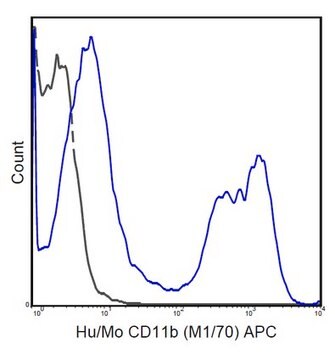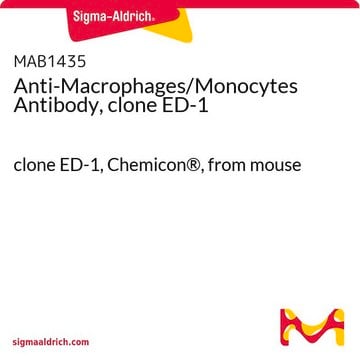MAB1852
Anti-Macrophages/Monocytes Antibody, clone MOMA-2
clone MOMA-2, Chemicon®, from rat
Sign Into View Organizational & Contract Pricing
All Photos(1)
About This Item
UNSPSC Code:
12352203
eCl@ss:
32160702
NACRES:
NA.41
Recommended Products
biological source
rat
Quality Level
antibody form
purified immunoglobulin
antibody product type
primary antibodies
clone
MOMA-2, monoclonal
species reactivity
mouse
manufacturer/tradename
Chemicon®
technique(s)
flow cytometry: suitable
immunohistochemistry: suitable
isotype
IgG2b
shipped in
wet ice
target post-translational modification
unmodified
Specificity
Recognizes an intracellular antigen of mouse macrophages and monocytes. It reacts strongly with macrophages in lymphoid organs such as tingible body macrophages and macrophages in T cell dependent areas and is extremely useful in immunohistochemistry. Reacts on all mouse strains tested.
Application
Detect Macrophages/Monocytes using this Anti-Macrophages/Monocytes Antibody, clone MOMA-2 validated for use in FC, IH.
Flow Cytometry: membrane permeabilization is recommended for this application.
Immunohistology: FRESH frozen sections at 1:25. The epitope recognized by MAB1852 is formaline sensitive. Fixation in fresh, acetone at 4°C or colder is strongly recommended. Specimens must be completely air dried after acetone fixation. Formalin or PFA fixation is not recommended.
Because of the lower titer, enhanced detection systems such as our poly-HRP secondaries or biotin labelled secondary antibodies followed by SA-FITC are recommended.
Optimal working dilutions must be determined by end user.
Immunohistology: FRESH frozen sections at 1:25. The epitope recognized by MAB1852 is formaline sensitive. Fixation in fresh, acetone at 4°C or colder is strongly recommended. Specimens must be completely air dried after acetone fixation. Formalin or PFA fixation is not recommended.
Because of the lower titer, enhanced detection systems such as our poly-HRP secondaries or biotin labelled secondary antibodies followed by SA-FITC are recommended.
Optimal working dilutions must be determined by end user.
Research Category
Inflammation & Immunology
Inflammation & Immunology
Research Sub Category
Inflammation & Autoimmune Mechanisms
Inflammation & Autoimmune Mechanisms
Physical form
Format: Purified
Protein A Purified mouse immunoglobulin in 10 mM sodium phosphate buffer (pH 7.4), 0.15 M NaCl, and 0.1% sodium azide as a preservative..
Protein A purified
Storage and Stability
Maintain for 1 year at 2–8°C from date of shipment. Aliquot to avoid repeated freezing and thawing. For maximum recovery of product, centrifuge the original vial after thawing and prior to removing the cap.
Analysis Note
Control
Macrophages, monocytes, lymphoid organs
Macrophages, monocytes, lymphoid organs
Other Notes
Concentration: Please refer to the Certificate of Analysis for the lot-specific concentration.
Legal Information
CHEMICON is a registered trademark of Merck KGaA, Darmstadt, Germany
Disclaimer
Unless otherwise stated in our catalog or other company documentation accompanying the product(s), our products are intended for research use only and are not to be used for any other purpose, which includes but is not limited to, unauthorized commercial uses, in vitro diagnostic uses, ex vivo or in vivo therapeutic uses or any type of consumption or application to humans or animals.
Not finding the right product?
Try our Product Selector Tool.
Storage Class Code
12 - Non Combustible Liquids
WGK
WGK 2
Flash Point(F)
Not applicable
Flash Point(C)
Not applicable
Certificates of Analysis (COA)
Search for Certificates of Analysis (COA) by entering the products Lot/Batch Number. Lot and Batch Numbers can be found on a product’s label following the words ‘Lot’ or ‘Batch’.
Already Own This Product?
Find documentation for the products that you have recently purchased in the Document Library.
Johannes Schödel et al.
Atherosclerosis, 206(2), 383-389 (2009-04-11)
We previously reported that deletion of brain type neuronal nitric oxide synthase-alpha (nNOS-alpha) accelerates atherosclerosis in apolipoproteinE (apoE) knockout (ko) mice. The regulation of nNOS expression is complex, involving the generation of mRNA splice variants. The current study investigates occurrence
Pouneh Kermani et al.
The Journal of clinical investigation, 115(3), 653-663 (2005-03-15)
The neurotrophin brain-derived neurotrophic factor (BDNF) is required for the maintenance of cardiac vessel wall stability during embryonic development through direct angiogenic actions on endothelial cells expressing the tropomysin receptor kinase B (TrkB). However, the role of BDNF and a
Courtney Netherland-Van Dyke et al.
Journal of cardiology and therapeutics, 3(2), 53-63 (2015-09-29)
WIN55,212-2, a potent synthetic agonist of cannabinoid receptor type 1 (CB1) and cannabinoid receptor type 2 (CB2), reduces atherosclerosis in apolipoprotein E (ApoE) null mice. Although pharmacologic evidence suggests the anti-atherosclerotic effects of WIN55,212-2 are mediated via CB2, this remains
Muriel G Blin et al.
Journal of molecular and cellular cardiology, 130, 76-87 (2019-04-01)
The progression of atherosclerosis is based on the continued recruitment of leukocytes in the vessel wall. The previously described role of CD146 in leukocyte infiltration suggests an involvement for this adhesion molecule in the inflammatory response. In this study, we
Faezeh Vasheghani et al.
The American journal of pathology, 182(4), 1099-1106 (2013-02-05)
Osteoarthritis (OA) is an age-related progressive degenerative joint disease. Peroxisome proliferator-activated receptor gamma (PPARγ), a transcription factor, is suggested as an attractive therapeutic target to counteract degradative mechanisms associated with OA. Studies suggest that activation of PPARγ by its agonists
Our team of scientists has experience in all areas of research including Life Science, Material Science, Chemical Synthesis, Chromatography, Analytical and many others.
Contact Technical Service








